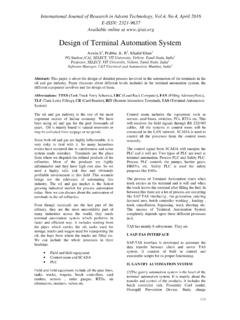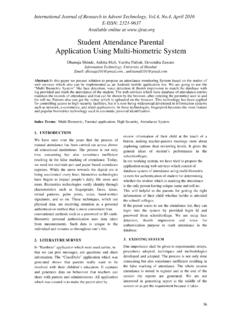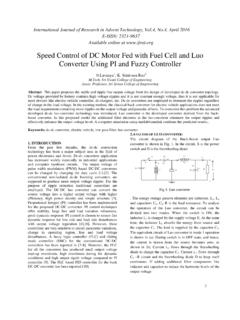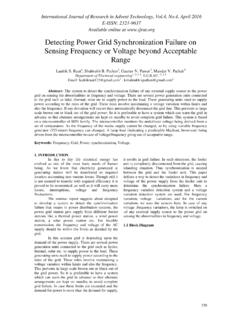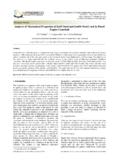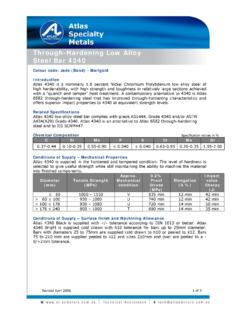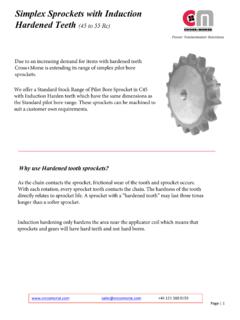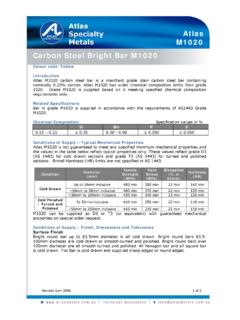Transcription of Metallurgical Analysis of Cracks Encountered …
1 International Journal of Research in Advent Technology, , Issue 4, April 2014 E-ISSN: 2321-9637 295 Metallurgical Analysis of Cracks Encountered During Induction Hardening of Crankshafts Mohit Sharma 1, Jasjeet Singh Kohli2, Shalom Akhai3 1UG Student, Department of Materials & Metallurgical Engineering, PEC University of Technology (Formerly Punjab Engineering College), Chandigarh, India-160012 2 UG Student, Department of Materials & Metallurgical Engineering, PEC University of Technology (Formerly Punjab Engineering College), Chandigarh, India-160012 3 Assistant Professor, Department of Materials & Metallurgical Engineering, PEC University of Technology (Formerly Punjab Engineering College), Chandigarh, India-160012 Email: ABSTRACT In this case study, Metallurgical Analysis of defects Encountered during Induction Hardening of crankshafts has been done in detail.
2 Major rejections occur during induction hardening due to cracking of the crankshafts after Induction Hardening/Tempering. Hence, in order to find the root cause of failure & to study the different defects during induction hardening process study was carried out, aim of the case study was to find out reasons behind the Cracks , to study the process of induction hardening and the defects Encountered during the induction hardening process. A complete failure Analysis was done on rejected crankshafts which had developed defects during induction hardening. Different parameters were taken into consideration and various tests were performed to find the reason behind the failure. In the end some corrective actions and suggestions will be provided in order to improve the process and to counter the reasons that cause cracking of crankshafts during induction hardening.
3 Index Terms- Induction Hardening; Surface Hardness; MPI; Case Depth; Austenite grain size; Stereoscopy; SEM. 1. INTRODUCTION Induction Hardening process: Induction hardening is a form of heat treatment in which a metal part is heated by induction heating and then quenched [3]. The quenched metal undergoes a martensitic transformation, increasing the hardness and brittleness of the part. Induction hardening is used to selectively harden areas of a part or assembly without affecting the properties of the part as a whole. The generated electric current in varying magnetic fields known as EDDY CURRENT . These eddy currents generated are responsible for the heating up of the work piece. Induction heating is a non contact heating process which utilizes the principle of electromagnetic induction to produce heat inside the surface layer of a work-piece.
4 By placing a conductive material into a strong alternating magnetic field, electrical current can be made to flow in the material thereby creating heat due to the I2R losses in the material. The current generated flows predominantly in the surface layer, the depth of this layer being dictated by the frequency of the alternating field, the surface power density, the permeability of the material, the heat time and the diameter of the bar or material thickness. By quenching this heated layer in water, oil or a polymer based quench the surface layer is altered to form a martensitic structure which is harder than the base metal It is a widely used process for the surface hardening of steel. The components are heated to a temperature within or above the transformation range followed by immediate quenching.
5 The core of the component remains unaffected by the treatment and its physical properties are those of the bar from which it was machined, whilst the hardness of the case can be within the range 37/58 HRC. Carbon and alloy steels with an equivalent carbon content in the range are most suitable for this process [1]. 2. LITERATURE REVIEW Induction Hardening parameters Frequency Power consumption Heating time Voltage Current Defects during induction hardening Different types of defects are Encountered during induction hardening, such as: International Journal of Research in Advent Technology, , Issue 4, April 2014 E-ISSN: 2321-9637 296 Overheating and burning of steels: Occur due to selection of wrong power and time settings. Dimension of the job and the material and the final product should be kept in mind while setting the power and time parameters to avoid overheating and burning of steels.
6 Cracks /Quench Cracks : Very high cooling rate results in Cracks , low concentration of quenchant and high severity can result in quench Cracks . Internal residual stresses: Due to expansion and contraction during the process, stresses are generated in the job that can harm it at later stages and under working conditions. Dimensional changes: It also occurs due to the expansion and contraction of the material during the heating and cooling of the job and during the formation of martensite. Soft spots: these spots of lower hardness can result due to improper agitation of the quenchant and due to leftover lubricants and other impurities on the surface of the job. Proper cleaning of the job before hardening and proper agitation of the bath are necessary to avoid soft spots.
7 Low hardness: improper temperature selection, quench severity and hardening time result in lower hardness than required. Geometry and material should be studied properly in order to set the above said parameters to achieve desired hardness level. Quenching Quenching is the rapid cooling of a work piece to obtain certain material properties [3]. In metallurgy, it is most commonly used to harden steel by introducing martensite, in which case the steel must be rapidly cooled through its eutectoid point, the temperature at which austenite becomes unstable. Types of quenchants Quenchants: Selection of quenchant depends on many factors, such as: Cooling rate required Hardness required Material properties hardenability A number of quenchants available today are: Gases Oil that may contain a variety of additives Water Aqueous polymer solutions Water that may contain salt or caustic additives Out of these mentioned quenchants, polymers are the most widely used quenchant in industries.
8 Polymer quenchants consist of solutions of organic polymers in water and contain corrosion inhibitors and other additives to produce concentrates, which are further diluted to give ready-to-use quenching solutions. The various types of polymer quenchant have widely differing properties. Great flexibility of quenching characteristics is possible through selection of the type of polymer, polymer concentration, temperature of the bath and degree of agitation. Several different types of organic polymers [17] are used including: PAG Polyalkylene glycol ACR Sodium polyacrylate PVP Polyvinyl pyrrolidone PEO Polyethyloxazoline. Technical Advantages 1. Flexibility of quenching speed: By varying the concentration, temperature and agitation of the polymer solution, it is possible to achieve a range of cooling rates, thus enabling the treatment of a wide variety of materials and components.
9 2. Elimination of soft spots: By producing a uniform polymer film around the component, the steam pocketing and soft spot problems often associated with water quenching after induction hardening can be avoided. 3. Reduction of stresses and distortion: The uniform film also reduces thermal gradients and residual stresses associated with water quenching and can, therefore, give substantial reduction in distortion during the solution heat treatment of aluminum alloys. 4. Tolerance to water contamination: Large amounts of water contamination can be tolerated before concentration (and hence quenching speed) is influenced significantly. This eliminates the soft spot, distortion and cracking. Production Advantages 1. Reduced cost: Depending upon the type of polymer and the concentration required, the in-tank costs of diluted polymer quenchants can be considerably lower than those of quenching oils.
10 Because polymer solutions have significantly lower viscosities than quenching oils, drag-out and hence replenishment requirements are reduced. 2. Easier cleaning: Components may not require cleaning before tempering. Residual films of polymers will not char, as with oils, but will decompose fully at high temperatures to form water vapor and oxides of carbon. Components may be tempered directly after quenching, thereby eliminating the need for costly alkali cleaning or vapor degreasing operations. 3. Reduced temperature rise during quenching: Polymer quenchant solution have almost twice the specific heat capacity to that of quenching oils. Therefore, for a given charge weight, the temperature rise during quenching will be approximately halved. International Journal of Research in Advent Technology, , Issue 4, April 2014 E-ISSN: 2321-9637 297 Most widely used polymer quenchant in the industry today are based on PAG (Polyalkylene Glycol).
